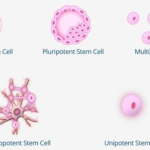Stem cells have been a hot topic for years, and there aren't many signs of slowing down anytime soon. It's difficult to deny the possibilities that stem cells could offer in regenerative medicine, such as treating Parkinson’s disease or spinal cord injuries.
But there are still many myths about them—and some controversies too. In this article we will explore some of these myths and controversies surrounding stem cells, including what they really are, how they work, and how they can be used in the future to help develop cures for diseases like cancer!
Let’s recap: what are stem cells?
Stem cell research is a very broad field Scientists and doctors hope stem cell research will help us to understand how diseases occur. They also hope that stem cells can be used to generate new cells to replace diseased ones, it's a new breakthrough called Regenerative Medicine. In general they can be thought of as "building blocks" for the body. These cells have the unique ability to transform into any type of cell that the body may need to help it heal.
There are many misconceptions and controversies surrounding the use of stem cells therapeutically. However, we’re here to help you better understand how stem cells are incredibly important to helping the body heal.
Myth: Using stem cells is considered new-age science and it's not reliable.
False.
Scientists have researched stem cells and how they work for over 70 years. In the last 20 years, medical procedures have been developed based on the concept of how stem cells work inside our own body.
The first successful isolation of human stem cells was in 1998, and since then they have been used to study diseases including cancer. In the future, we hope that these discoveries will lead us closer toward help for disorders such as Parkinson's disease or spinal cord injuries!
Myth: All stem cells are taken from embryos.
False.
Stem cells can be taken from a variety of sources, such as bone marrow in adults. The stem cell procedure is completely safe for the donor, and adult stem cells have proven to be as effective as embryonic stem cells for many procedures.
Myth: Stem cells aren't FDA-approved, so they are unsafe.
False.
The FDA has approved the use of stem cells in clinical trials for over a decade, and they are currently being used to treat certain blood cancers like leukemia and lymphoma. While the approval isn't universal for all treatments, scientists are constantly testing and searching for new ways for the body to use these amazing cells.
Myth: Stem cell therapy can cure any disease or injury.
False - but not too far from reality, either.
Stem cells have been found to be helpful in treating a number of diseases, including cancer and diabetes. They can also help with joint pain, arthritis, and spinal cord injuries. At Vitality Integrative Wellness, we use the power of Regenerative Medicine to help patients who suffer from:
- Knee pain or knee arthritis (loss of meniscal cartilage)
- Shoulder pain or shoulder arthritis (rotator cuff tears, labrum damage)
- Lumbar or low back degenerative joint disease (facet)
- Cervical or neck degenerative joint disease (facet)
- Peripheral Neuropathy (numbness, tingling or burning of the legs and feet)
- Ligament or tendon tears
- Cartilage degeneration or cartilage damage (tears, etc.)
- Bursitis
- Tendinitis
The Bottom Line
The body has an incredible ability to heal itself, but sometimes it just needs a little extra help. We can get that help from the stem cells that exist inside your body. And although many are skeptical of their effectiveness, there is no question that they can help people who suffer from many ailments. At Vitality Integrative Wellness, we have helped our patients experience incredible success with Regenerative Medicine.
If your body needs a little extra help to heal itself, find out if Regenerative Medicine is the next right step for you. Schedule a consultation with us!


